A Tourist’s Guide to Visiting Beopjusa Temple in 2024
What is Beopjusa Temple?
Beopjusa Temple is a Buddhist temple in central South Korea, and a leading temple in the Jogye Order of Korean Buddhism. It is a UNESCO World Heritage Site alongside six other Buddhist temples across the country which collectively make up Sansa, Buddhist Mountain Monasteries in Korea.
It is the seven monasteries combined which are recognised by UNESCO. The other six are Daeheungsa, Buseoksa, Tongdosa, Magoksa, Seonamsa and Bongjeongsa.
Sansa, Buddhist Mountain Monasteries in Korea, are one of 16 current UNESCO World Heritage Sites within the country.
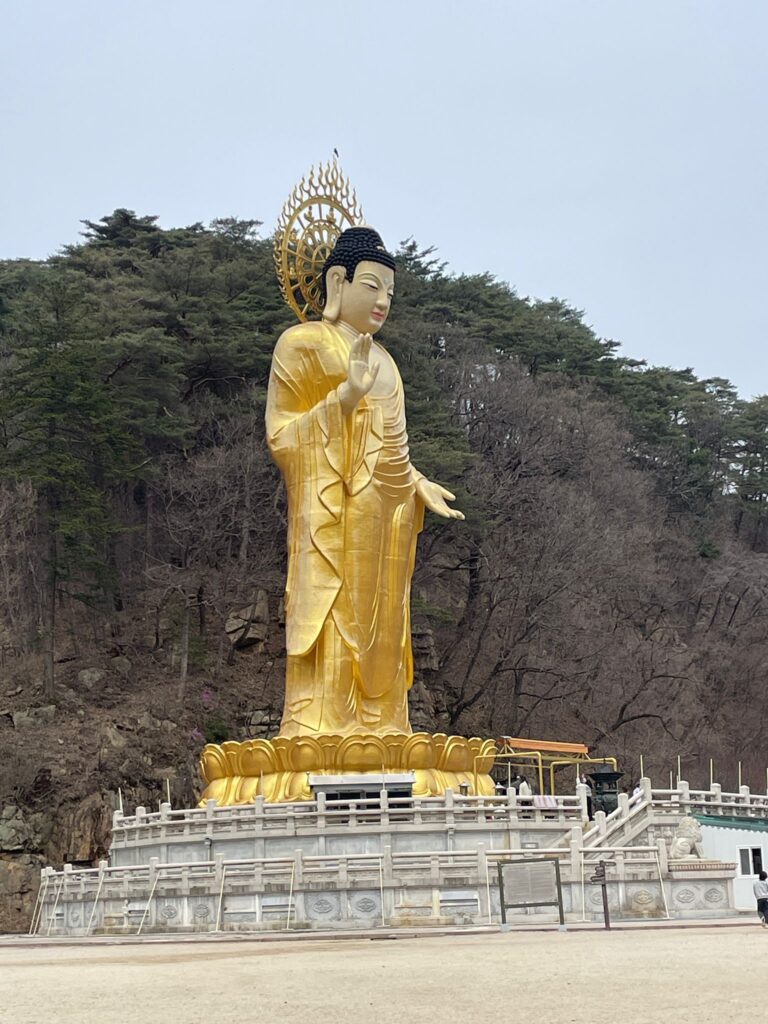
Where is it Located?
It is on Songnisan Mountain, almost bang in the centre of South Korea. Songnisan is in the province of Chungcheongbuk-do.
As you may have worked out in the previous section, it is located in the mountains. Although you don’t need to hike to get there.
From the edge of town it will take around 20 minutes of walking time to head through the forest towards the temple, which is located in Songnisan National Park. The terrain is pretty flat, therefore it won’t feel like you’re walking uphill here.
There are many great hiking trails nearby if you have more than a day to spend here.
How can you get There?
You can catch a bus to Songnisan Bus Terminal (속리산 in Korean). From there it takes around 25 minutes to walk to the temple. Please note that Songnisan may also be listed as Sokrisan, so if you buy a ticket to Sokrisan then don’t worry because it is still the correct destination.
Here is a list of bus stations that offer transport to Songnisan and how much a ticket costs. Unfortunately only one-way tickets are available. Therefore you have to buy your return when you arrive.
Buses from Seoul are fairly infrequent, with only 4 per day going between the capital and Songnisan. Although there are more regular buses coming from more local towns and cities such as Cheongju and Boeun.
The prices don’t necessarily reflect the length of the journey.
| Destination | One-way ticket | Return ticket | Journey time (Approximate) |
|---|---|---|---|
| Boeun | ₩2,400 (£1.40/US$1.78) | ₩4,800 (£2.80/US$3.56) | 22 minutes |
| Cheongju | ₩10,800 (£6.32/US$7.99) | ₩21,600 (£12.64/US$15.98) | 1 hour 48 minutes |
| Nam Cheongju | ₩9,700 (£5.68/US$7.18) | ₩19,400 (£11.36/US$14.36) | 1 hour 28 minutes |
| Daejon | ₩9,900 (£5.80/US$7.33) | ₩19,800 (£11.60/US$14.66) | 1 hour 38 minutes |
| Dong Seoul | ₩20,700 (£12.12/US$15.32) | ₩41,400 (£24.24/US$30.64) | 3 hours 46 minutes |
| Central City (Seoul) | ₩19,900 (£11.65/US$14.73) | ₩39,800 (£23.30/US$29.46) | 3 hours 29 minutes |
| Nam Seoul (Seoul Nambu) | ₩19,900 (£11.65/US$14.73) | ₩39,800 (£23.30/US$29.46) | 3 hours 23 minutes |
| Suwon | ₩19,800 (£11.59/US$14.65) | ₩39,600 (£23.18/US$29.30) | 3 hours 34 minutes |
| AnSan | ₩21,200 (£12.41/US$15.69) | ₩42,400 (£24.82/US$31.38) | 4 hours 31 minutes |
| Sangpan | ₩1,700 (£1/US$1.26) | ₩3,400 (£2/US$2.52) | 2 minutes |
| Annae | ₩4,600 (£2.69/US$3.40) | ₩9,200 (£5.38/US$6.80) | 1 hour 27 minutes |
| Okcheon | ₩7,000 (£4.01/US$5.18) | ₩14,000 (£8.02/US$10.36) | 1 hour 23 minutes |
| Chang-ri | ₩5,000 (£2.93/US$3.70) | ₩10,000 (£5.86/US$7.40) | 47 minutes |
| Miwon | ₩6,300 (£3.69/US$4.66) | ₩12,600 (£7.38/US$9.32) | 2 hours 18 minutes |
Alternatively, you can drive. Parking outside the temple costs ₩5,000 (£2.93/US$3.70) and the address of Beopjusa Temple is 405, Beopjusa-ro, Songnisan-myeon, Boeun-gun, Chungcheongbuk-do.
What are the Opening Hours and how Much Does it Cost?
Beopjusa Temple is open from sunrise until sunset every day.
It is free to enter.
There are reports online that talk about an entrance fee. As of April 2024 it is free to enter. I went here as a solo traveller on the day I started writing this post and the turnstiles were wide open with the ticket office left unmanned.
When is the Best Time to Visit?
The temple is open year-round. However you should be aware of the best time to visit South Korea and plan your trip around that.
Beopjusa Temple is best visited during the pleasant spring or autumn seasons. These attract relatively small crowds whilst also offering good weather.
How Long Does it Take to Visit Beopjusa Temple?
You can easily see all the highlights in under an hour. If you wish to read all the information plaques and spend time exploring the incense and souvenir stands then you will be here for around two hours.
Therefore I would recommend 1-2 hours to visit Beopjusa Temple.
You will easily be able to see everything in this timeframe, and will not need longer unless you explore at a very leisurely pace, or spend time enjoying a drink just outside the entrance.
Map of Beopjusa Temple
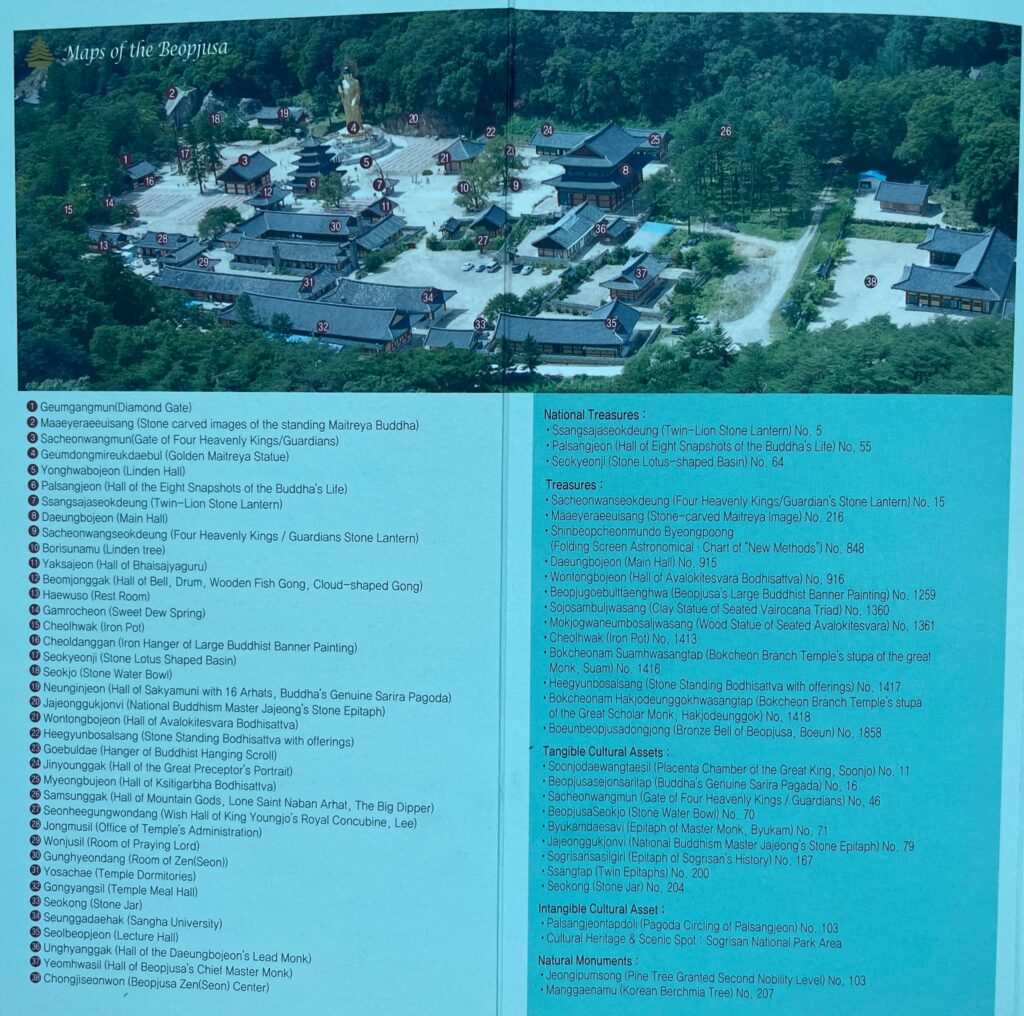
What is the History of Beopjusa Temple?
The temple was founded in the year 553 AD during the era of the Shilla Dynasty. The founder was Master Monk Euishin, who built it after being inspired by a trip to India where he learnt more about Buddhist teachings.
Beopjusa Temple went on to become a key site for Maitreya Buddhism, a belief in the world’s future Buddha. The word “maitreya” translates as friendship.
The temple grew to its peak with around 130 buildings during the Joseon Dynasty era, only for most of it to be razed during the Japanese invasion of South Korea in the late 1500s.
It has since been rebuilt on multiple occasions. As has the Golden Maitreya Buddha, which was rebuilt most recently as a giant bronze statue in 2005. At the same time the main hall was renovated.
Today the temple remains open as a place to enjoy for tourists and monks alike. It retains its usage as one of the most important places to follow Maitreya Buddhism, whilst also boasting a wide array of tangible cultural assets in the form of many buildings and treasures within the complex.
Food, Drink, Shops and Toilet Facilities at Beopjusa Temple
Food and Drink
For food and drink, you cannot get it inside the complex itself, however just outside (literally a 30-second walk from the entrance) is a small cafe selling a series of drinks.
I went for the iced schisandra tea, and wasn’t a fan in all honesty. It was overpriced, half of it was literal ice cubes and the taste was bang average. The prices here are tourist trap prices and you can find much better options back in Songnisan town.
As for food, you will have to go all the way back to the town, unless you fancy Korean taffy which is sold at the small souvenir stands just outside the complex, and halfway along the short walking trail from the town to the temple.
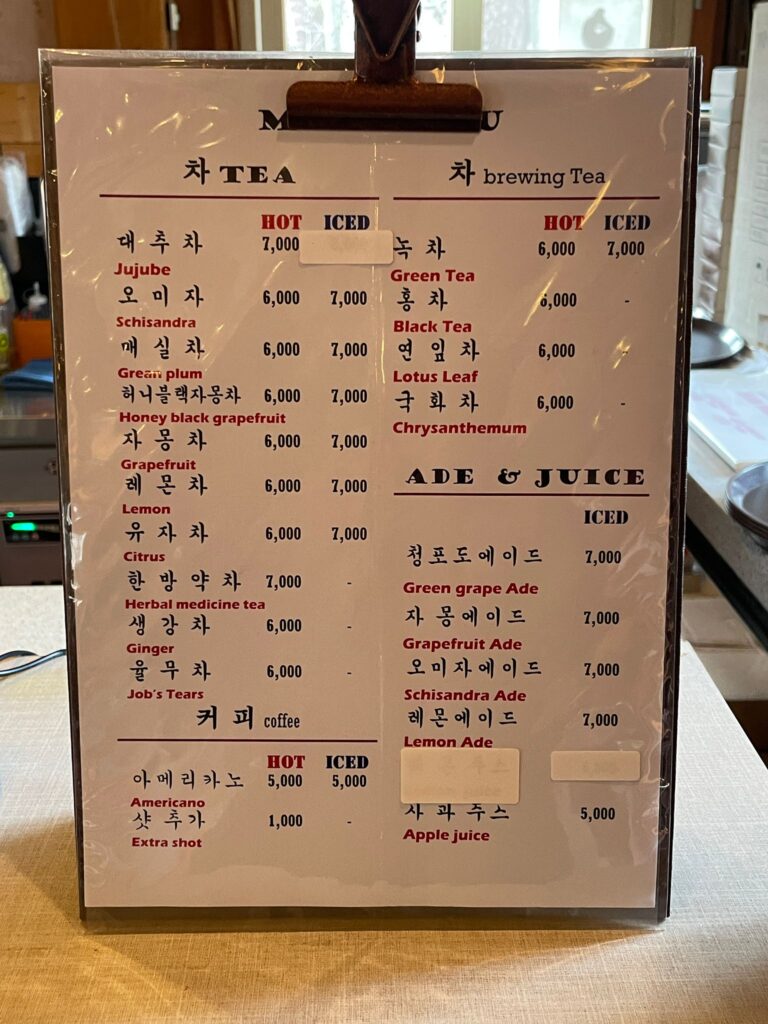
Shops
There are a small number of shops located in and around the temple complex. They sell either small trinkets as souvenirs (and Korean taffy – a popular local sweet) or incenses and other religious offerings.
There is one souvenir shop around halfway between Songnisan town and Beopjusa Temple. A second is to the left, just outside the entrance gate, and a third just inside the complex, again to the left.
One place selling incense is at the base of the Golden Maitreya Statue, whilst another is towards the back of the complex, around where sites 9 and 23 are located on the map.
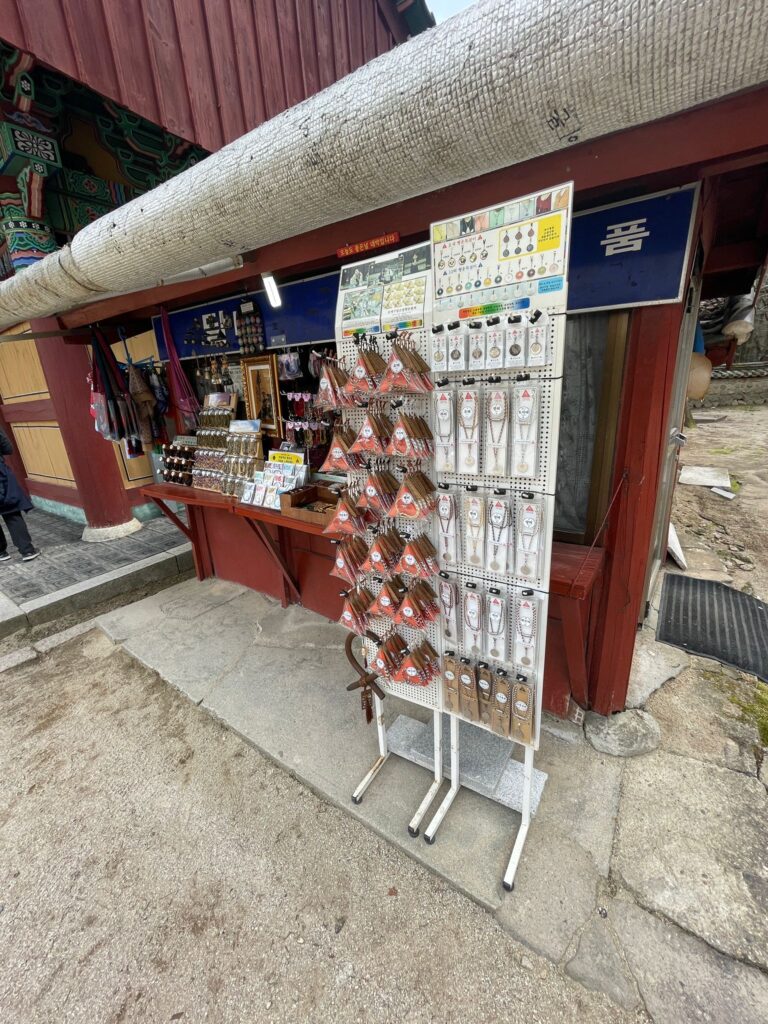
Toilets
There is one block of toilets inside Beopjusa Temple. These are located to the far right just inside the entrance. On the map posted above they are number 13. Male and female toilets are located next to each other. In fact, you can even see the temple’s main attraction, the Golden Maitreya Statue from inside the toilets!
There are also toilets just as you enter the forest trail from Songnisan town, exactly a 16-minute walk from the temple itself.
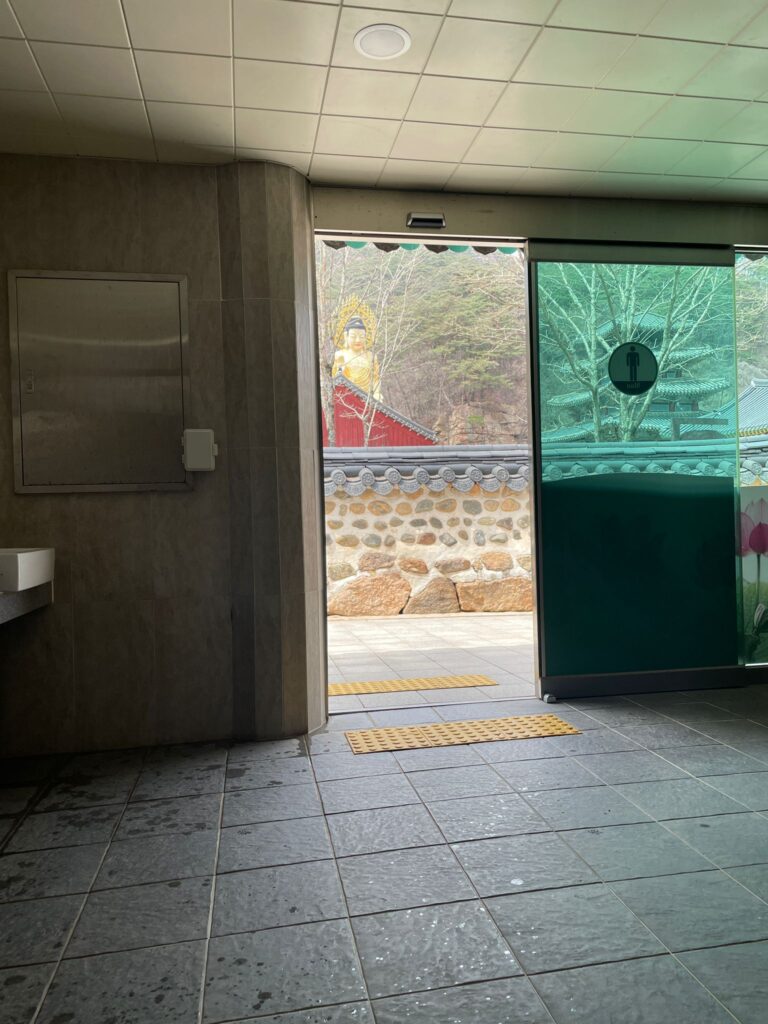
What can you see at Beopjusa Temple?
Geumgangmun (Diamond Gate)
Number 1 on the map. The Diamond Gate is the entry point to this particular temple. It is built in typical Korean style, and inside the gate are four colourful statues which are worth checking out.
Although you will see some better colourful statues a few seconds later. I’ll explain those ones in more detail next.
Outside the gate are a series of signs in Korean. It is important to know that no pets are allowed and you face fines of up to ₩2,000,000 (£1,171/US$1,480) if you disobey this. The primary reason is to respect the local wildlife. Another sign points out that it’s important to be quiet within the temple grounds.
Welcome to Beopjusa Temple.

Sacheonwangmun (Gate of Four Heavenly Kings)
Number 3 on the map. As soon as you enter the Diamond Gate, a second gate lies right in front of you.
A few weeks before coming here, I went to beautiful Bongeunsa Temple in Seoul during a day trip and learnt all about the Four Heavenly Kings.
In Buddhism, the kings are Gods, with each of them representing a specific compass direction (north, south, east, west). They are Vaisravana (King of the North), Virudhaka (King of the South), Dhrtarastra (King of the East) and Virupaksa (King of the West).
They often stand at the entrance to Buddhist temples, with two on the left and two on the right as you enter. The statues are pretty impressive and usually painted with a series of vibrant colours.
The Sacheonwangmun is the largest Four Heavenly Kings Gate in South Korea.
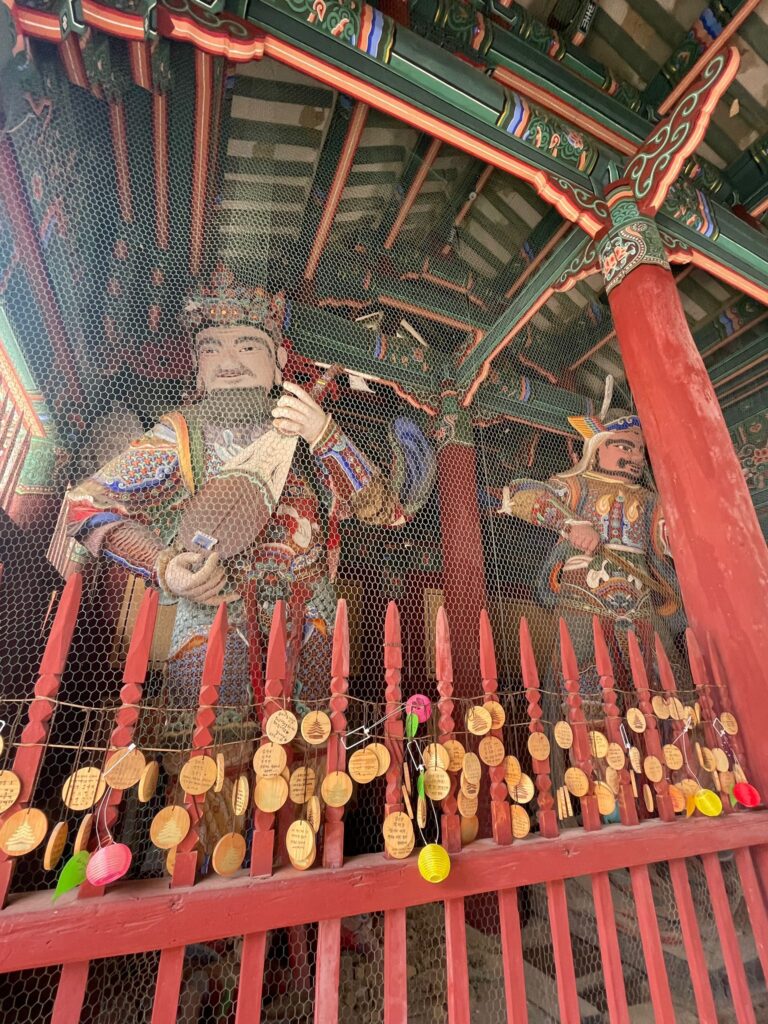
Geumdongmireukdaebul (Golden Maitreya Statue)
Number 4 on the map. The most iconic structure within Beopjusa Temple is the first you will see, even before the Diamond Gate. At 33m tall it is not hard to see why.
The statue was initially built in 776AD, although it was then moved to Seoul by the father of King Gojong of the Joseon Dynasty, and ultimately rebuilt three times in the last century, most recently in the early 2000s.
In all honesty it was seeing cool pictures of this statue that made me want to visit Beopjusa Temple in the first place, and it certainly didn’t disappoint.

Palsangjeon (Hall of Eight Snapshots of the Buddha’s Life)
Number 6 on the map. The last remaining 5-story wooden pagoda in South Korea. As the name suggests, there are eight paintings inside, each depicting a key part of Buddha’s life.
They are: an announcement of his mother (Queen Mayadevi) conceiving him, Buddha’s birth, practicing asceticism (avoiding indulgences for religious reasons), witnessing the four human sufferings (birth, ageing, sickness and death), the Great Renunciation, initial enlightenment, full enlightenment and ascension into Nirvana (similar to heaven).
Palsangjeon is one of the coolest buildings to see here from the outside. Although on the inside it, whilst still pretty awesome, doesn’t stand out compared to other buildings within the complex.
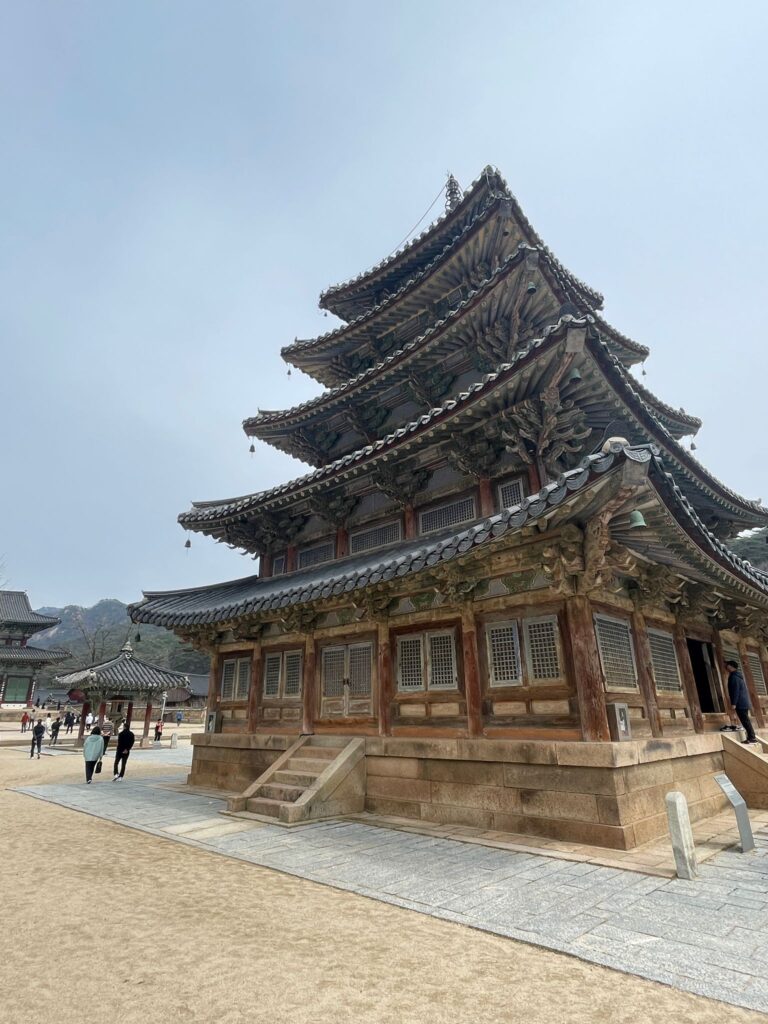
Beomjonggak (Hall of Bell, Drum, Wooden Fish Gong, Cloud-Shaped Gong)
Number 12 on the map. This hall houses four percussion instruments that were used to create Buddha’s teaching sound. They are as follows:
- Beomjong (Temple bell): Initially used to tell the time, or prompt people to gather. The bell is now used to mark morning services, evening services and certain Buddhist ceremonies
- Beopgo (Dharma drum): This drum alerts people to the timing for major ceremonies. It is often beat after the Beomjong rings and is also said to liberate all sentient creatures in heaven and hell
- Mokeo (Wooden fish gong): Representative of all water creatures. Again, it was once used to gather people outside the temple, but has since become something that is used to mark the beginning of ceremonies
- Unpan (Cloud gong): Whilst Beopgo represents all sentient creatures in heaven and hell, Unpan stands for those in the sky. It is also said to help lead spirits of the dead towards Buddha’s Pure Land for rebirth
The four instruments cannot be touched, as the hall is closed off for visitors. However you can see all of them clearly because the hall has no walls. Therefore you can stand very close to them regardless.
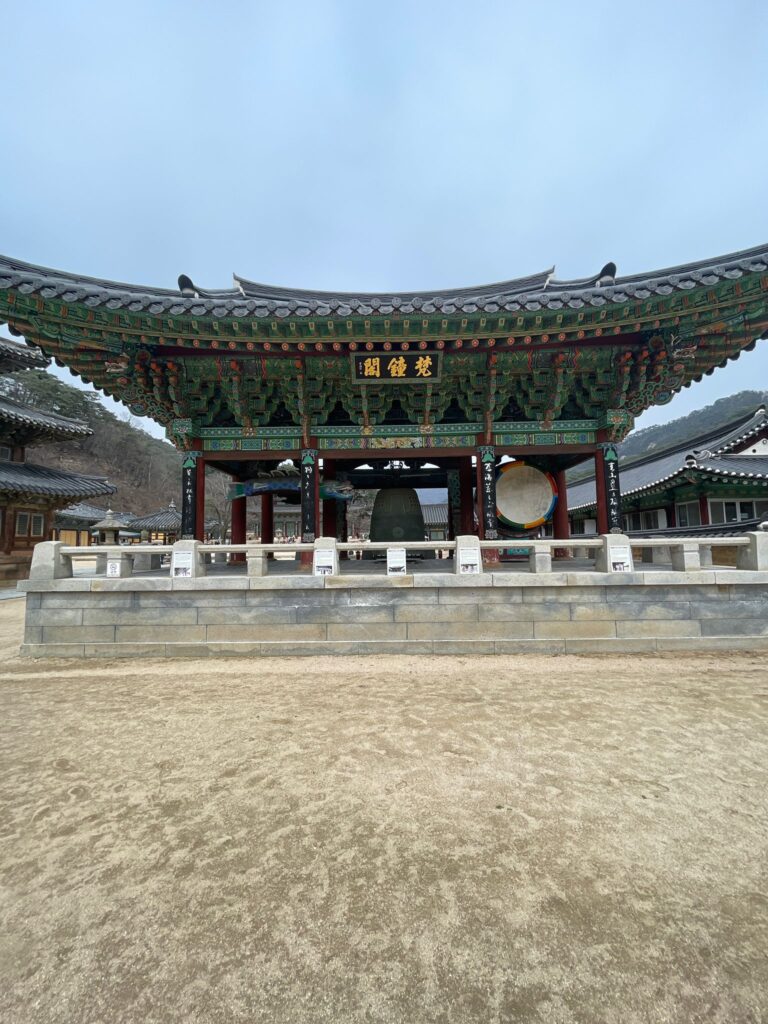
Daeungbojeon (Main Hall)
Number 8 on the map. The largest building at the back of the complex. It was built in the middle of the Goryeo Dynasty (918-1392 AD) and restored on multiple occasions since, most recently in 2005.
Daeungbojeon is Treasure 915 on South Korea’s Heritage Search which lists the National Treasures of South Korea alongside other treasures and cultural properties. They describe cultural heritage as being properties worthy of preservation, and it’s no surprise to see this beautiful building make the list. In fact, it is regarded as one of South Korea’s three best Buddhist prayer halls. The others are Gakhwangjeon Hall (Hwaeomsa Temple) and Geungnakjeon Hall (Muryangsa Temple).
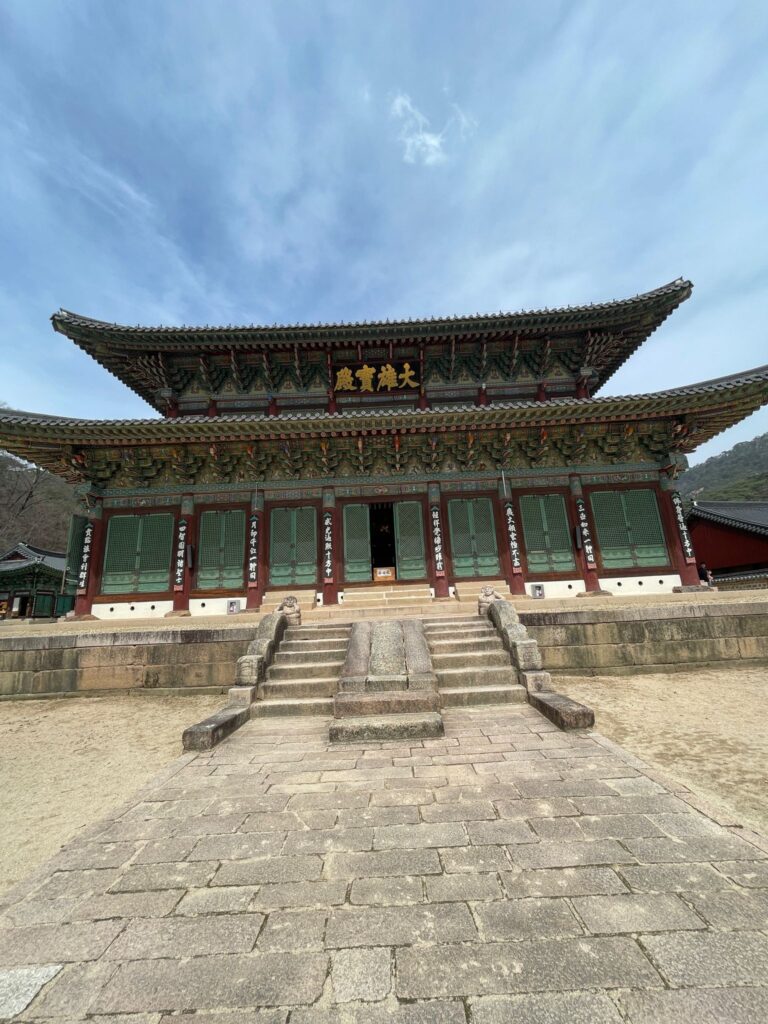
Can I Stay Overnight in the Temple?
Yes. There is a Templestay program which allows you to stay overnight and learn more about Korean Buddhism. The programs involve a series of activities related to learning about the history and getting involved in Buddhist culture and traditions.
Costs vary for each program. However the three advertised at the time of writing cost from ₩30,000-₩100,000 (£17.52-£58.39 or US$22.16-US$73.88).
Keep an eye on the Templestay website for current information if you wish to get involved in one.
My Thoughts on Beopjusa Temple
I’ve been living and working in South Korea as an English teacher for 8 months at the time of writing. You can read a post I wrote on the requirements for teaching English in South Korea if this type of career opportunity interests you.
And Beopjusa Temple was seriously impressive. The towering Golden Maitreya Buddha near the entrance was what piqued my interest to begin with, and it didn’t disappoint.
I previously went to the awesome Bongeunsa Temple in Seoul, and saw many Buddhist sites in Myanmar, the best being Shwedagon Pagoda. Therefore the bar was pretty high.
Now Shwedagon Pagoda was one of the most spectacular places I’ve ever visited, so Beopjusa Temple wasn’t quite as good as that. But this is like saying Liverpool weren’t quite as good as Manchester City for most of the early 2020s. In other words, Beopjusa is still amazing, regardless of how good other sites may be.
Most tourists will be coming from Seoul. With a 7-hour round trip I’d suggest staying in Songnisan for one night (or more if you wish to hit the many hiking trails nearby). Almost every other tourist at the site will be Korean, so it is perhaps a little “off the beaten track” for a western tourist. But I guess that just adds to the appeal.
Whilst Beopjusa Temple doesn’t quite draw the same attention as the likes of Gyeongbokgung Palace or the DMZ, it’s still a site that you should consider putting on your South Korea bucket list.
Watch this space for more articles in the coming weeks on the coolest places to visit in South Korea.
